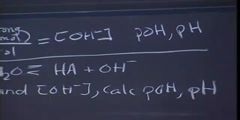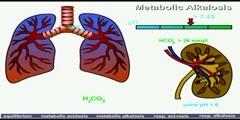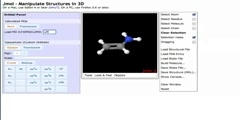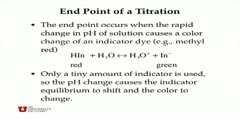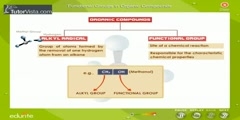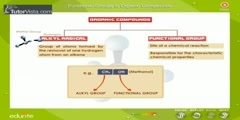Lec 16 - Recognizing Functional Groups
"Lec 16 - Recognizing Functional Groups Freshman Organic Chemistry (CHEM 125) This lecture continues the discussion of the HOMO/LUMO view of chemical reactivity by focusing on ways of recognizing whether a particular HOMO should be unusually high in energy (basic), or a particular LUMO should be unusually low (acidic). The approach is illustrated with BH_3, which is both acidic and basic and thus dimerizes by forming unusual "Y" bonds. The low LUMOs that make both HF and CH_3F acidic are analyzed and compared underlining the distinction between MO nodes that derive from atomic orbitals nodes (AON) and those that are antibonding (ABN). Reaction of HF as an acid with OH- is shown to involve simultaneous bond-making and bond-breaking. 00:00 - Chapter 1. Why So High, Why So Low? The HOMO/LUMO View of Chemical Reactivity 15:19 - Chapter 2. Is BH3 an Acid or a Base? 25:38 - Chapter 3. HOMO-LUMO Mixing for Reactivity and Resonance: The Cases of HF 34:49 - Chapter 4. Comparing HF and CH3F to Distinguish Molecular Orbital Nodes Complete course materials are available at the Open Yale Courses website: http://open.yale.edu/courses This course was recorded in Fall 2008.
Video is embedded from external source so embedding is not available.
Video is embedded from external source so download is not available.
Channels: Chemistry (General)
Tags: HOMO LUMO bonding antibonding lewis acid lewis base vacant orbital
Uploaded by: yalefreshorganic ( Send Message ) on 05-09-2012.
Duration: 50m 8s
Here is the next lecture for this course
Lec 15 - Chemical Reactivity: SOMO, HOMO, ...
47:12 | 2806 viewsLec 44 - Acid Base Introduction
18:37 | 3044 viewsIdentification of Amico Acid Functional G ...
04:14 | 3326 viewsChemical Science - Lewis Diagrams - Lectu ...
45:49 | 12903 viewsLec 2 - Force Laws, Lewis Structures and ...
50:13 | 2677 viewsVideo lecture: acid-base equilibrium
50:05 | 18524 viewsLecture on acid-base equilibrium part 2
48:13 | 7262 viewsLecture on acid base titration
50:04 | 21651 viewsNurseReview.Org - Animation on Acid Base ...
00:27 | 23723 viewsOrbital Panel of Pi and Sigma Bonding
04:27 | 4766 viewsAcid-Base Titrations
09:27 | 6089 viewsMeet the SAM Team Jesse Lewis
01:49 | 2931 viewsFunctional Groups in Organic Compounds
01:14 | 6401 viewsOrganic Compounds And Their Functional Groups
01:14 | 4538 viewsLec 37 - Interview with Dr. Arthur B. Lewis
01:55:21 | 2312 viewsNo content is added to this lecture.
This video is a part of a lecture series from of Yale
Lecture list for this course
Lec 2 - Force Laws, Lewis Structures and Resonance
Lec 3 - Double Minima, Earnshaw's Theorem and Plum-Puddings
Lec 4 - Coping with Smallness and Scanning Probe Microscopy
Lec 6 - Seeing Bonds by Electron Difference Density
Lec 7 - Quantum Mechanical Kinetic Energy
Lec 8 - One-Dimensional Wave Functions
Lec 9 - Chladni Figures and One-Electron Atoms
Lec 10 - Reality and the Orbital Approximation
Lec 11 - Orbital Correction and Plum-Pudding Molecules
Lec 12 - Overlap and Atom-Pair Bonds
Lec 13 - Overlap and Energy-Match
Lec 14 - Checking Hybridization Theory with XH_3
Lec 15 - Chemical Reactivity: SOMO, HOMO, and LUMO
Lec 17 - Reaction Analogies and Carbonyl Reactivity
Lec 18 - Amide, Carboxylic Acid and Alkyl Lithium
Lec 19 - Oxygen and the Chemical Revolution (Beginning to 1789)
Lec 20 - Rise of the Atomic Theory (1790-1805)
Lec 21 - Berzelius to Liebig and Wöhler (1805-1832)
Lec 22 - Radical and Type Theories (1832-1850)
Lec 23 - Valence Theory and Constitutional Structure (1858)
Lec 24 - Determining Chemical Structure by Isomer Counting (1869)
Lec 25 - Models in 3D Space (1869-1877); Optical Isomers
Lec 26 - Van't Hoff's Tetrahedral Carbon and Chirality
Lec 27 - Communicating Molecular Structure in Diagrams and Words
Lec 28 - Stereochemical Nomenclature; Racemization and Resolution
Lec 29 - Preparing Single Enantiomers and the Mechanism of Optical Rotation
Lec 30 - Esomeprazole as an Example of Drug Testing and Usage
Lec 31 - Preparing Single Enantiomers and Conformational Energy
Lec 32 - Stereotopicity and Baeyer Strain Theory
Lec 33 - Conformational Energy and Molecular Mechanics
Lec 34 - Sharpless Oxidation Catalysts and the Conformation of Cycloalkanes
Lec 35 - Understanding Molecular Structure and Energy through Standard Bonds
Lec 36 - Bond Energies, the Boltzmann Factor and Entropy
Lec Last - Potential Energy Surfaces, Transition State Theory and Reaction Mechanism








